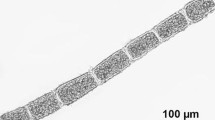Abstract
Calcium excretion and deposition were studied during sporogenesis in the myxomycete,Physarella oblonga. Prior to fruiting, the migrating vegetative plasmodium contains numerous, large channels connected to the external environment. During early sporangial development, these channels become smaller and are isolated as channel remnants. Plasmodial microfilament bundles also disappear at this time. Internally, two types of spheres, each about 0.5–1.5 μm in diameter, are formed in the channel remnants. A dense sphere appears to originate from small particles initially secreted from the mitochondria. These particles then enter the channels and channel remnants by reverse pinocytosis and fuse to form the dense spheres. A second, less dense sphere has no detectable cytoplasmic origin but also appears to form in the channels and channel remnants. Both types of spheres are concentrated by the fusion of channel remnants to form enlarged regions (knots and spikes) of the developing capillitium. Some of the channel remnants also fuse with the outer surface of the sporangium, depositing both spheres to the outside. Both spheres have been studied by various light and electron microscopic techniques and with specific histochemical and analytical procedures. The less dense spheres appear to contain a major portion of calcium in the form of calcium carbonate. These results are compared to other recent studies on calcium deposition in the Myxomycetes and a different mechanism for calcium deposition is proposed.
Similar content being viewed by others
References
Allera, A., Wohlfarth-Bottermann, K. E.: Extensive fibrillar protoplasmic differentiations and their significance for protoplasmic streaming. IX. Aggregation states of myosin and conditions for myosin filament formation in the plasmodia ofPhysarum polycephalum. Cytobiologie6, 261 (1972)
Braatz, R., Komnick, H.: Histochemischer Nachweis eines Calcium-pumpenden Systems in Plasmodien von Schleimpilzen. Cytobiologie2, 457 (1970)
Braatz, R., Komnick, H.; Vacuolar calcium segregation in relaxed myxomycete protoplasm as revealed by combined electrolyte histochemistry and energy dispersive analysis of X-rays. Cytobiologie8, 158 (1973)
Daniel, J. W., Järlfors, U.: Plasmodial ultrastructure of the myxomycetePhysarum polycephalum. Tissue and Cell4, 15 (1972a)
Daniel, J. W., Järlfors, U.; Light-induced changes in the ultrastructure of a plasmodial myxomycete. Tissue and Cell4, 405 (1972b)
Eanes, E. D., Posner, A. S.: Structure and chemistry of bone mineral. In: Biological calcification: cellular and molecular aspects, (Schraer, H., ed.), p. 1–26. New York: Appleton-Century-Crofts 1970
Ettienne, E.: Subcellular localization of calcium repositories in plasmodia of the acellular slime moldPhysarum polycephalum. J. Cell Biol.54, 179 (1972)
Farley, F. E.: Ultrastructural observation of morphogenesis in the myxomycetePhysarella oblonga formaalba. (Ph. D. Dissertation). Bowling Green: Bowling Green State University 1972
Farr, M. L.: Some new myxomycete records for the neotropics and some taxonomic problems in the Myxomycetes. Proc. Iowa Acad. Sci.81, 37 (1974)
Gomori, G.: Microscopic histochemistry principles and practice. p. 33–35, Chicago: University of Chicago Press 1952
Gustafson, R. A., Thurston, E. L.: Calcium deposition in the myxomyceteDidymium squamulosum. Mycologia66, 397 (1974)
Guttes, S., Guttes, E., Hadek, R.: Occurrence and morphology of a fibrous body in the mitochondria of the slime moldPhysarum polycephalum. Experientia (Basel)22, 452 (1966)
Hatano, S.: Specific effect of Ca2+ on movement of plasmodial fragments obtained by caffeine treatment. Exp. Cell Res.61, 199 (1970)
Hatano, S., Oosawa, F.: Movement of cytoplasm in plasmodial fragments obtained by caffeine treatment. I. Its Ca++ sensitivity. J. Physiol. Soc. Japan33, 589 (1971)
Kóssa, J. von: Über die im Organismus künstlich erzeugbaren Verkalkungen. Beitr. path. anat. allg. Path.29, 163 (1901)
Lehninger, A. L.: Mitochondria and calcium ion transport. Biochem. J.119, 129 (1970)
Luft, J.: Improvements in epoxy resin embedding methods. J. biophys. biochem. Cytol.9, 409 (1961)
Mangenot, G.: Sur le pigment et le calcaire chezFuligo septica Gmel. C. R. Soc. Biol. (Paris)111, 936 (1932)
Martin, G. W., Alexopoulos, C. J.: The Myxomycetes, p. 242–243. Iowa City: University of Iowa Press 1969
McManus, Sister M. A.: Ultrastructure of myxomycete plasmodia of various types. Amer. J. Bot.52, 15 (1965)
Nachmias, V. T.: Electron microscope observations on myosin fromPhysarum polycephalum. J. Cell Biol.52, 648 (1972)
Nicholls, T. J.: The effects of starvation and light on intramitochondrial granules inPhysarum polycephalum. J. Cell Sci.10, 1 (1972)
Niklowitz, W.: Über den Feinbau der Mitochondrien des SchleimpilzesBadhamia utricularis. Exp. Cell Res.13, 591 (1957)
Reynolds, E. S.: The use of lead citrate at high pH as an electron-opaque stain in electron microscopy. J. Cell Biol.17, 208 (1963)
Rhea, R. P.: Electron microscopic observations on the slime moldPhysarum polycephalum with specific reference to fibrillar structures. J. Ultrastruct. Res.15, 349 (1966)
Schuster, F. L.: Electron microscope observations on spore formation in the true slime moldDidymium nigripes. J. Protozool.11, 207 (1964)
Schuster, F. L.: A deoxyribonucleic acid component in mitochondria ofDidymium nigripes, a slime mold. Exp. Cell Res.39, 329 (1965)
Stewart, P. A., Stewart, B. T.: Membrane formation during sclerotization ofPhysarum polycephalum plasmodia. Exp. Cell Res23, 471 (1961)
Watson, M. L.: Staining of tissue sections for electron microscopy with heavy metals. J. biophys. biochem. Cytol.4, 475 (1958)
Note added in proof
Schoknecht, J. D.: SEM and X-ray microanalysis of calcareous deposits in Myxomycete fructifications. Trans. Amer. Micros. Soc.94, 216 (1975) contains results complementary to our work.
Author information
Authors and Affiliations
Rights and permissions
About this article
Cite this article
Bechtel, D.B., Horner, H.T. Calcium excretion and deposition during sporogenesis inPhysarella oblonga . Calc. Tis Res. 18, 195–213 (1975). https://doi.org/10.1007/BF02546240
Received:
Accepted:
Issue Date:
DOI: https://doi.org/10.1007/BF02546240




